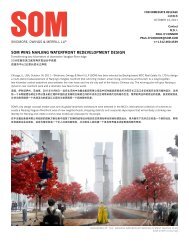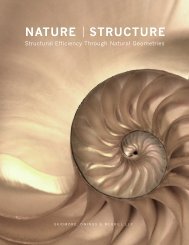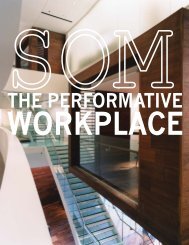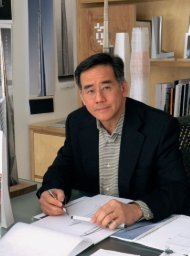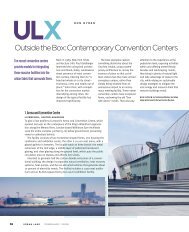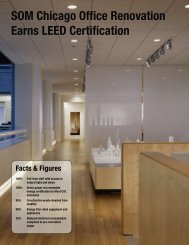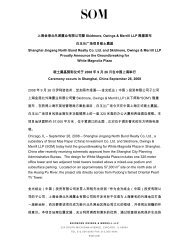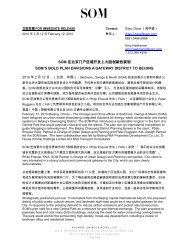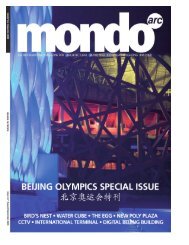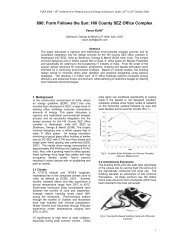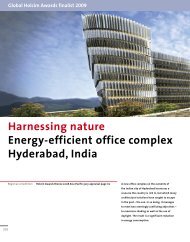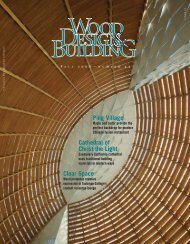nature structure - Skidmore, Owings & Merrill LLP
nature structure - Skidmore, Owings & Merrill LLP
nature structure - Skidmore, Owings & Merrill LLP
You also want an ePaper? Increase the reach of your titles
YUMPU automatically turns print PDFs into web optimized ePapers that Google loves.
<strong>nature</strong> <strong>structure</strong><br />
structural efficiency Through natural geometries<br />
skidmore, owings & merrill llp
1<br />
IntroductIon<br />
2<br />
Growth Patterns<br />
China world Trade Center Competition<br />
3<br />
Mesh-tube<br />
Jinling Hotel Tower Competition<br />
4<br />
dIaGonal screen FraMes<br />
poly international plaza<br />
5<br />
hurrIcane strenGth<br />
Transbay Tower Competition<br />
6<br />
sacred GeoMetrIes<br />
The Cathedral of Christ the light<br />
7<br />
PIvotal MoveMent<br />
The pin-Fuse Joint ®<br />
8<br />
the rocker<br />
The new Beijing poly plaza<br />
9<br />
the web<br />
The new Beijing poly plaza
1<br />
IntroductIon<br />
Biomimicry: structural efficiency<br />
Through natural geometries<br />
As building <strong>structure</strong>, organic bracing<br />
is capable of fragmenting forces by<br />
sharing loads more uniformly within<br />
the <strong>structure</strong> and transferring them<br />
into the building foundation.<br />
inspired by the efficiency and adaptability of natural organisms,<br />
the som san Francisco structural engineering studio develops<br />
sustainable structural solutions for some of the world’s tallest<br />
buildings. “Forms found in <strong>nature</strong> have superior engineering,<br />
inherent memory, and a great deal of elasticity,” says director<br />
mark sarkisian, pe, se, leed ® Ap. Amalgamating engineering<br />
with biology enables high-rises to be super-efficient and durable.<br />
The benefits of using organic precedents for som projects<br />
has had a resonating effect throughout a design, improving<br />
the overall quality.<br />
For nearly a decade, many of som’s most iconic tower designs<br />
have synthesized biomimicry (derived from the words bios,<br />
meaning life, and mimic, meaning imitate) and structural<br />
system design. Biological influences have led to innovative<br />
strategies in som architecture, yielding elegant, sustainable<br />
tower designs with high value in the global development market.<br />
sarkisian began by investigating the cross-section of natural<br />
<strong>structure</strong>s that exhibit an exponential growth pattern with<br />
mathematically predictable segmentations that brace the form,<br />
considering the growth patterns of bamboo and the fractal<br />
geometry of the chambered nautilus shell for clues about<br />
natural strength. The high-rise applications of these principles<br />
borrow specific sequences of the organic <strong>structure</strong>s to replicate<br />
their most attractive attributes: a high strength-to-weight ratio,<br />
elasticity, long-term endurance, and a highly efficient form<br />
that resists loads and maximizes stability. As building <strong>structure</strong>,<br />
organic bracing is capable of fragmenting forces by sharing<br />
loads more uniformly within the <strong>structure</strong> and transferring<br />
them into the building foundation.<br />
som’s building systems like the pin-fuse Joint ® and the new<br />
Beijing poly plaza’s rocker mechanism use the agility of<br />
systems found in <strong>nature</strong> to enhance their ability to cope with<br />
large forces. Applied to buildings in areas of high seismicity,<br />
these systems supply superior longevity to the <strong>structure</strong>. “The<br />
performance, reliability, and repairability of structural elements<br />
in the seismic force resisting system contribute to sustainable<br />
design. Time and cost savings can also be achieved since the<br />
building will be less disrupted for repair or rebuilding after an<br />
earthquake,” reports seAonC’s sustainable design Committee.<br />
new organic structural strategies rely on biological precedents<br />
to manage resource consumption and have a global impact<br />
on climate preservation. By integrating biomimicry into high-<br />
rises, som has increasingly refined and economized many<br />
structural forms, yielding multiple environmental benefits to<br />
the local microclimate over conventional <strong>structure</strong>s. The use<br />
of efficient structural forms similar to those found in <strong>nature</strong><br />
reduces the overall volume of materials required and eliminates<br />
large quantities of waste. less building mass allows more<br />
ventilation to penetrate the urban landscape and prevents the<br />
urban degradation of natural wind flows which aid ventilation<br />
and cooling. it also increases the opportunities for natural<br />
daylight through enhanced connectivity to the outdoors.<br />
Additionally, reducing the surface area of the built mass<br />
minimizes thermal exchanges with the urban environment<br />
that disrupt its natural state.
2<br />
Growth Patterns<br />
China world Trade Center Competition
even when subjected to tsunamis,<br />
bamboo responds effectively and<br />
efficiently to lateral loads exhibiting<br />
the genius of natural structural<br />
properties and geometric proportioning.<br />
while som developed the competition scheme for the China<br />
world Trade Center, Beijing, interest in bamboo as an<br />
architectural form led to the discovery of the properties of<br />
bamboo and how they might relate to the extreme high-rise.<br />
The natural formation of bamboo reveals unique structural<br />
characteristics. long, narrow stems provide support for large<br />
foliage during its growing life while providing strong and<br />
predictable support for man-made <strong>structure</strong>s after harvesting.<br />
even when subjected to tsunamis, bamboo responds effectively<br />
and efficiently to lateral loads exhibiting the genius of natural<br />
structural properties and geometric proportioning. The nodes<br />
or diaphragms, as seen in rings over the height of the culm<br />
or stack, are not evenly spaced—closer at the base, further<br />
apart through the mid-height, and close again near the top.<br />
These diaphragm locations are not random and can be<br />
predicted mathematically. They are positioned to prevent<br />
buckling of the thin bamboo walls when subjected to gravity<br />
and lateral loads. This growth pattern is common to all bamboo.<br />
The wall thicknesses and diameter of the culm can be similarly<br />
calculated. They are also proportioned to prevent buckling of<br />
the culm. All equations that define the diaphragm locations,<br />
diameter, and wall thickness are based on a quadratic<br />
formulation. when plotting the required diameter of the culm<br />
against height (with the relationships of diaphragms and wall<br />
thicknesses similar), it mimics the bending loading diagram of<br />
a cantilever subjected to uniform lateral loads—the engineering<br />
theory is the same for bamboo and other cantilevered <strong>structure</strong>s.<br />
Bamboo consists of a culm, or stem, comprised of nodes and<br />
internodes. nodes mark the location of diaphragms and provide<br />
the location for new growth. A slight change in diameter exists<br />
at node locations. internodes exist between nodes. internodes<br />
are hollow creating an inner cavity surrounded by a culm wall.<br />
material in the culm is located at the farthest point from the<br />
stem’s neutral axis, providing greatest bending resistance,<br />
allowing gravity loads to exist only in the outside skin which<br />
impedes uplift due to lateral loads and minimizes overall<br />
weight. The cellular <strong>structure</strong> of the bamboo wall reveals<br />
tighter cellular density near the outer surface of the wall and<br />
less density near the inner wall. Again reinforcing the idea of<br />
maximum material efficiency when subjected to bending loads.<br />
The geometric characteristics of bamboo are applied to the<br />
structural systems of the China world Trade Center Tower<br />
Competition submission. The tower is divided into eight<br />
segments along its height. The structural demand from lateral<br />
load is highest at the base of the culm (or tower) therefore<br />
internode heights are smaller compared to the mid-height.<br />
smaller spacing increases moment capacity and buckling<br />
resistance. Beyond the mid-height of the culm (or tower) the<br />
heights of the internodes decrease proportionally with the<br />
diaphragm diameter. Thus, the form of the culm (tower)<br />
responds to structural demands due to lateral loads. The<br />
competition scheme for the China world Trade Center<br />
super<strong>structure</strong> developed with an internal core interconnected<br />
to a perimeter tube at mathematically defined locations to<br />
brace the frame against buckling in accordance with the growth<br />
pattern of bamboo are extremely efficient.
3<br />
Mesh-tube<br />
Jinling HoTel Tower CompeTiTion
The grid, which provides the outer<br />
structural frame, replicates the strong<br />
mesh of biological cell <strong>structure</strong>s. This<br />
frame consists of a closely spaced<br />
diagonal membrane that is much tighter<br />
than a conventional diagrid form.<br />
drawing upon biology for structural concept for the Jinling<br />
Hotel Tower Competition in nanjing, China enabled substantial<br />
reductions to be made in the amount of structural material and<br />
size of the structural members required for the perimeter<br />
frame. The spacing of the horizontal and vertical members<br />
in the frame of the tower utilize an efficient ratio. A smaller<br />
material mass for the structural frame allowed the som design<br />
team to enhance the quality of the interior spaces with natural<br />
daylight access, views, and natural ventilation while lowering<br />
its carbon footprint and environmental impact.<br />
The mesh tube <strong>structure</strong> for this innovative tower is a hybrid<br />
of previously developed orthogonal structural systems and<br />
recently developed organic systems. The grid, which provides<br />
the outer structural frame, replicates the strong mesh of<br />
biological cell <strong>structure</strong>s. This frame consists of a closely spaced<br />
diagonal membrane that is much tighter than a conventional<br />
diagrid form. “To resist lateral loads and achieve the goal of<br />
100% structural efficiency, the verticals and the horizontals<br />
in the lateral system are combined to create a fine diagonal<br />
mesh, where every member is in tension or compression<br />
without bending, resulting in a <strong>structure</strong> that is optimally<br />
efficient with the strength and stiffness for a tall building,”<br />
explains mark sarkisian. The external <strong>structure</strong> doubles as an<br />
integrated shading device, mitigating energy-intensive cooling<br />
loads from solar heat gains on the glazed façade. The structural<br />
grid members are designed to be manufactured off-site to<br />
minimize construction waste and reduce on-site construction time.<br />
As the building height increases, the concentric floor plates<br />
rotate to give the tower mass its organic structural stability.<br />
The spacing between the four vertical massing elements gets<br />
tighter at mid-height then the forms converge at the base so<br />
that the ground floors provide rigidity and balance while the<br />
upper floors are able to be less rigid where the wind forces<br />
are naturally greatest.
4<br />
dIaGonal<br />
screen Fr aMes<br />
poly inTernATionAl plAzA
natural forms and the goal of minimizing<br />
a <strong>structure</strong>’s carbon footprint lead to<br />
som’s structural advancements.<br />
in 2007, natural forms and the goal of minimizing a <strong>structure</strong>’s<br />
carbon footprint lead to som’s structural advancements in the<br />
design of the multi-award-winning poly international plaza in<br />
guangzhou, China. The design for this tower uses principles<br />
of the natural segmented structural bracing found in plant<br />
organisms to form the innovative double lattice structural<br />
screen frame. external braces were engineered to support<br />
the loads of the column-free floor plates in the exceptionally<br />
slender, almost “billboard-like” towers. “The south working<br />
frame has two levels of diagonalization, working with the<br />
vertical piers to manage loads,” mark sarkisian explains of<br />
this perimeter <strong>structure</strong>. with the introduction of only three<br />
two-story diagonal steel members at the mid-height and top<br />
of the building, the south-braced frame was engaged with<br />
the north conventional frame in resisting lateral loads in the<br />
narrow dimension of the towers.<br />
The super-efficient <strong>structure</strong>s of poly international plaza provide<br />
a high degree of openness and minimize the use of virgin<br />
materials to achieve a dramatically lower carbon footprint. The<br />
planar external bracing <strong>structure</strong> on the south facade, which<br />
sarkisian says, “was purposely pulled forward off the external<br />
wall to control temperatures,” acts as an integrated self-shading<br />
device controlling excessive heat gain and glare, especially in<br />
the summer months when sun angles are high. The spacing<br />
between the bracing <strong>structure</strong> permits low winter sun angles<br />
to bring daylight and warmth to the interior spaces during the<br />
cooler months. The design team implemented a shallow floor<br />
plan concept, which enhances natural daylight penetration in<br />
the building, improving the quality of the interior spaces,<br />
increasing productivity, and lowering energy demands for<br />
lighting. The bracing system on the south façade allows for a<br />
conventional orthogonal frame on the north façade resulting<br />
in open views to the pearl river.
5<br />
hurrIcane<br />
strenGth<br />
TrAnsBAy Tower CompeTiTion
Founded in the Fibonacci sequence<br />
and proportional to the spiral patterns<br />
of a nautilus shell or a hurricane, the<br />
structural grid was developed with a<br />
scaling factor that is most concentrated<br />
at a point and spirals out, becoming<br />
less concentrated.<br />
designed to exceptional standards of structural safety and<br />
environmental consciousness, the Transbay Tower Competition<br />
design for san Francisco, a city of high seismic risk, was an<br />
evolution of the external structural designs developed for the<br />
Jinling Tower and poly international projects. The groundbreaking<br />
structural form, which is the result of the elegant<br />
adaptation of natural forces to the building <strong>structure</strong>, has an<br />
inherent organic symbolism and creates a unique design<br />
derived from the forces experienced in san Francisco.<br />
The structural grid composition was based on the specific<br />
mathematical derivation of the perfect cantilever originally<br />
developed by Anthony mitchell in 1904, offering an exceptionally<br />
strong and efficient geometry. Contrary to conventional belief,<br />
the purest cantilever is one with a bulbus shape, composed<br />
of radial force flow lines. Founded in the Fibonacci sequence<br />
and proportional to the spiral patterns of a nautilus shell or<br />
a hurricane, the structural grid was developed with a scaling<br />
factor that is most concentrated at a point and spirals out,<br />
becoming less concentrated. “The inner areas of the hurricane<br />
have the highest level of force with the forces reducing along<br />
the spiralling arms,” describes mark sarkisian of the energy<br />
that’s created by the natural forces of a hurricane.<br />
influenced by the hurricane, sarkisian and his team developed<br />
a <strong>structure</strong> that would respond to the natural concentration<br />
of force in this super-tall tower. According to sarkisian:<br />
“The spiralling form provides the resistance and is based on<br />
the idea that every reaction has an equal and opposite reaction.<br />
The spiral, which has the greatest resistance at the center and<br />
the least resistance at the outer arms, was translated into<br />
bracing that would resist the lateral loads where they were<br />
naturally the highest with the tightest part of the spiral and<br />
lowest where the bracing was more open. The diagonals<br />
radiate from the corners of the tower where forces are the<br />
highest and transform to more open geometries near the top<br />
where forces are lowest. The applied wind load increases with<br />
height, therefore it is best to reduce the building plan size to<br />
reduce the surface area that will be subjected to wind. integral<br />
forces generated by ground motions during an earthquake are<br />
collected within the super<strong>structure</strong> and transmitted back into<br />
the ground. They too are attracted to supports in a radial fashion.”<br />
This bold structural move allowed the design team to use the<br />
bracing for control of heat gain through shading of the façade<br />
while allowing for natural daylight and ventilation.
6<br />
sacred GeoMetrIes<br />
THe CATHedrAl oF CHrisT THe ligHT
many natural phenomena express this<br />
Fibonacci sequence in their geometric<br />
<strong>structure</strong>, including the sunflower seedpod<br />
and the shape of hurricane patterns.<br />
Two interlocking spheres create the principal geometry for<br />
The Cathedral of Christ the light. The planar section of the<br />
geometry results in the sacred “vesica piscis” form, evoking<br />
the symbol of a fish. The shape recalls the ancient symbol of<br />
congregation, implements a sign of Christianity, and responds<br />
to the site’s close proximity to water. These interpenetrating<br />
circles are related to one another through the square roots of<br />
2, 3, and 5, the first three digits of the Fibonacci sequence<br />
(other than binary digits). The height and the shape resulting<br />
from the intersecting circles are related by the square root<br />
of 3. The height, or the longitudinal length of the cathedral,<br />
is equal to the diameter times the square root of 3, or 1.7305,<br />
and the width or the transverse length of the cathedral is equal<br />
to the longitudinal length divided by the square root of 3. The<br />
geometric and mathematical applications of the resulting<br />
shape are the same as those commonly occurring in <strong>nature</strong><br />
and in the order of the universe itself. many natural phenomena<br />
express this sequence in their geometric <strong>structure</strong>, including<br />
the sunflower seedpod and the shape of hurricane patterns.<br />
The principle geometry defines the interior volume, while<br />
creating truncated vesici at the Alpha (genesis and the first<br />
letter of the greek alphabet) and omega (ending/everlasting<br />
and the last letter of the greek alphabet) walls. The reliquary<br />
walls used to define both the inside of the sanctuary and<br />
outside of the <strong>structure</strong> are formed by overlapping circles with<br />
the same radii, simply offset in plan. The interior sphericallydefined<br />
volume supported on the inside face of the reliquary<br />
wall is enclosed with a conical form supported on the outside<br />
face of the reliquary wall. The conical form, if continued to its<br />
apex, would close, but is instead truncated, symbolically referring<br />
to the Cathedral’s openness to the sky and thus, the heavens.<br />
As an extension of the Cathedral’s fundamental architectural<br />
concept, the great doors are inscribed with adjoining circles.<br />
when closed, the doors form the vesica piscis shape. The<br />
Fibonacci sequence orders their vertical articulation. Custom<br />
door pulls emerge directly from the vesica piscis, their surface<br />
texture a topographic map of the spiraling Fibonacci sequence.
Roof Skylight<br />
Oculus Ceiling<br />
Fritted Glass<br />
Wood Louvers<br />
Glu-lam Structure<br />
Omega Wall<br />
Alpha Wall<br />
Reliquary Wall<br />
Entry Vestibule
7<br />
PIvotal MoveMent<br />
THe pin-Fuse JoinT ®
Conventional structural steel Frame<br />
pin-Fuse Joint ® Frame<br />
pin-fuse Joints ® emulate<br />
the pivotal movements of<br />
a human shoulder joint to<br />
work with the shear<br />
stress forces.<br />
Conventional structural steel Frame<br />
subjected to an earthquake<br />
pin-Fuse Joint ® Frame subjected<br />
to an earthquake<br />
Conventional structural steel Frame<br />
Compromized after an earthquake<br />
pin-Fuse Joint ® Frame intact without<br />
permanent deformations after an<br />
earthquake<br />
while structural grid systems successfully provide exceptional<br />
strength and rigidity to som towers, resisting the shear forces<br />
of earthquakes also demand elasticity. explains sarkisian,<br />
“These buildings need to move, and where you find the need<br />
for movement the most is in certain areas of high seismicity.”<br />
incorporating his patented pin-fuse Joints ® , the internal<br />
structural elements of towers are designed to have superior<br />
ductile strength. pin-fuse Joints ® emulate the pivotal movements<br />
of a human shoulder joint to work with the shear stress forces.<br />
This joint uses materials that allow engineers to define a certain<br />
coefficient of friction, so the joint remains fixed and then it<br />
slips during high loads. As soon as the load gets large enough,<br />
the joints start to move. By using this joint to provide localized<br />
flexibility, the earthquake forces can be dissipated and damage<br />
to the <strong>structure</strong> minimized. The increased durability of the<br />
materials in som structural designs provides the environmental<br />
benefits of a lower initial carbon footprint and the economization<br />
of lower life-cycle costs.<br />
original concept sketch
8<br />
the rocker<br />
THe new BeiJing poly plAzA
inspiration for the<br />
three-story tall rocker<br />
mechanism came from<br />
the multi-direction<br />
rotation capabilities<br />
of the human arm.<br />
The new Beijing poly plaza is located in an area of high<br />
seismicity, similar to san Francisco. som pursued a design<br />
concept that would allow the building to be displaced when<br />
subjected to a major earthquake. As part of the design, the<br />
eight-story museum element was suspended by diagonal cables<br />
in the lofty 295-foot-tall daylit atrium space. To prevent<br />
overstress in the cables during a large earthquake, a cast-steel<br />
rocker mechanism was devised to allow the building to move<br />
without inducing force into the cables. “you are able to design<br />
for a force level that is much lower than it would have been<br />
if you fixed this connection,” says mark sarkisian, whose<br />
inspiration for the three-story tall rocker mechanism came<br />
from the multi-direction rotation capabilities of the human arm.<br />
statically the rocker mechanism stays in place, and then during<br />
an earthquake, the rocker moves. The rocker, which looks like<br />
a giant pulley system, is similar to the pin-fuse Joint ® concept.<br />
“The natural response of the joint in the body is to release<br />
itself; the muscles respond to the different configurations but<br />
ultimately keep a fairly modest size allowing that rotation arm<br />
movement to happen,” sarkisian explains.
9<br />
the web<br />
THe new BeiJing poly plAzA
it would be as if you took a spider web<br />
and filled glass panels over the top of<br />
individual cells and allowed for relative<br />
movement between those panels.<br />
The world’s largest cable-net supported glass wall enables<br />
daylight and views into the main atrium enclosure of The new<br />
Beijing poly plaza building. According to sarkisian, this wall,<br />
which moves with the wind loads in Beijing, shares its principles<br />
of flexibility with spider webs that move considerably when<br />
exposed to loads. “They have to be very elastic because other-<br />
wise they’ll fracture,” says sarkisian in reference to the delicate<br />
<strong>structure</strong> of spider webs. “it would be as if you took a spider<br />
web and filled glass panels over the top of individual cells and<br />
allowed for relative movement between those panels,” he explains.<br />
The cable net is stiffened by two V-shaped cables that are<br />
counterweighted by the suspended museum. This expansive<br />
glazed cable-net system resists gravity and lateral loads using<br />
the giant rocker mechanism to return to its original position<br />
after deformation.<br />
The flexibility of the web-like mesh system prevents fracturing<br />
under large loads, which eliminates future material waste. in<br />
this building, structural biomimicry helped som to advance<br />
structural innovation, create an iconic building, greatly reduce<br />
material quantities, and be sustainable in the process.



